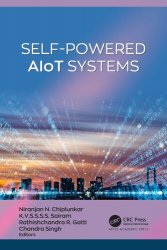 Название
Название: Self-Powered AIoT Systems
Автор: Niranjan N. Chiplunkar, K.V.S.S.S.S. Sairam, Rathishchandra R. Gatti
Издательство: Apple Academic Press, CRC Press
Год: 2025
Страниц: 357
Язык: английский
Формат: pdf (true)
Размер: 20.6 MB
This new volume focuses on design principles for building self-powered AIoT (artificial intelligence of things) applications and their subsequent deployment. The book introduces the futuristic concepts of AIoT by incorporating self-powered systems, firstly by informing the reader of current AI/ML techniques and IoT technologies and then showing the path towards convergence of AI/IoT towards AIoT. The book also explains the many possible diverse applications of AIoT.
The combination of IoT for sensing and aggregation of data from the surroundings and AI for analysis and decision-making will expand cyber-physical intelligence towards achieving complete autonomy. However, as the deployment of sensors becomes increasingly ubiquitous, there will be a massive amount of sensor data aggregation and analyses for autonomous decision-making capabilities of AIoT products. This calls for substantial research and product development in self-powered technologies such as energy harvesters, supercapacitors, energy storage devices for energy generation, and energy-efficient technologies such as ultra-low power (ULP) microcontrollers, ULP microprocessors, and ULP smart sensors and actuators. This volume helps to fill that gap.
The volume presents research and product development towards structured convergence of self-powered systems, leading to pragmatic R&D deliverables for new products and services. The book is the first of its kind on reporting how the current AI and IoT are progressing toward the vision of AIoT. It goes one step further by integrating AIoT with self-powered systems to make them fully autonomous. Convergence will happen as the data volume increases, which is why the IT giants are betting on AIoT. This volume explores the hidden compatibility of self-powered AIoT.
The future of ubiquitous systems and their deployment in the cyber-physical realms depends on the extent of integration of IoT with Artificial Intelligence (AI). Intelligence must also be ubiquitous by not limiting the IoT subsystems to data collection but also possessing a certain extent of Artificial Intelligence. This is called the artificial Internet of Things or AIoT and forms the crux of edge computing. Edge computing can work with centralized AI systems to form better systems. It is like the human nervous system, which has both reflex intelligence at the spinal cord level and centralized intelligence in the brain. However, unlike the human body, where the sensors, reflex, and centralized intelligence are encapsulated within a body, IoT sensors are present almost everywhere in an intelligence-enabled CPS.
Further, their operation is in wireless mode, which calls for repeated battery replacement. Since this is highly tedious, these AIoT devices must power themselves from the ambient environment. This book focuses on self-powered AIoT devices, which will be helpful for future ICT products. The book introduces the futuristic concepts of AIoT by incorporating self-powered systems, first by sensitizing the reader with current familiar AI/ML techniques and IoT technologies and then showing the path toward convergence of AI/IoT toward AIoT. Further, the book also explains the possible applications of AIoT. It will inspire readers to undertake research and product development toward structured convergence of self-powered systems, AI, and IoT, leading to pragmatic R&D deliverables for new products and services.
First, the book is the first of its kind reporting on how the current AI and IoT are progressing toward the vision of AIoT. It goes one step further by integrating AIoT with self-powered systems to make them fully autonomous. Second, convergence will happen as the data volume increases, which is why the IT giants are betting on AIoT. This implies the potential for a lot of research work is hidden in self-powered AIoT, and this book guides toward that path.
Скачать Self-Powered AIoT Systems
[related-news]
[/related-news]